Yesterday, July 8th 2018 was a very unusual day. I was invited to Southampton Solent University to receive an Honorary Degree in Technology. I got the invitation a few months ago and I have to say it is a really humbling feeling. As with all these things it is not individual effort that has led to this, but all the fantastic people I have had the opportunity to work with and share time with over the years. Also thank you everyone for you kind wishes and congratulations, likes and jibes online 🙂
My job that day was to join in with the rest of the academic body on stage and congratulate each of the 600 graduating students with a round of applause from the stage. Then I had my citation read out and the Chancellor handed me my tube and conferred the honor. Then I had a free form 5 minutes to talk to the students and families about the wonderful opportunities out there for them all. This part was the biggest honour of the day as a graduation day is a rare and special time. I talked a little about Choi Kwang Do and the milestones that we have in martial arts, and how getting a belt doesn’t mean stopping practicing and learning from the previous belts, its ongoing to learn and practice and the journey really does matter more than the destination. I also implored everyone to share and work together and most of all be nice, all the time if possible!
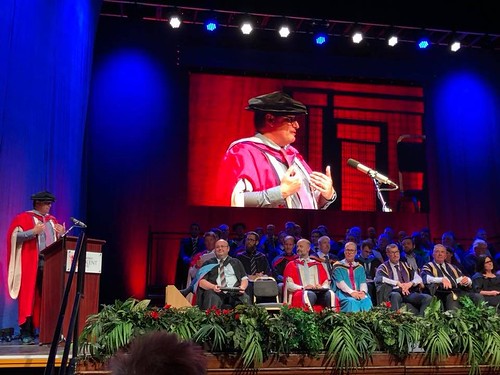
Also with me in gaining a Doctorate was Mark Sanger, Oscar winning film editor on Gravity (amongst many other fantastic films). He became a Doctor of Art. He gave a really good speech, and we commented afterwards how we said very similar things in different ways, which I hope helped get re-enforce our enthusiasm for getting on out in the World.
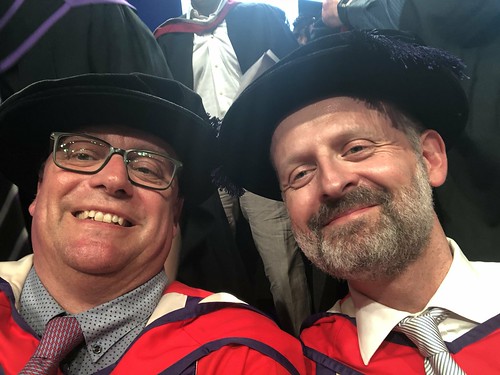
The university link is here but I am adding int he video from that page of the mini interview and roundup that the team did and put up really quickly!
education
Life in IoT, Pokemon, AR, Micro:bit, reports and scifi
I has been a few months since I wrote anything here. My new role at 451 Research has kept me doing a lot of writing about a lot of interesting subjects related to IoT. It is an interesting change to be on the receiving end of briefings where people tell me why their implementation or product direction is of interest, yes that’s bit poacher turned game keeper, but it is good to be able to share and build upon all my previous experience. The Internet of Things is huge and diverse, because like the internet it underpins everything. The great thing is it also include how we as people understand what is going on in a system, which lends itself to being able to discuss virtual and augmented reality. I had started to cover some VR and just posted a longer report spotlight on AR when Pokemon Go hit. It was only a matter of time before a mass market awareness thing happened, but few of us knew the form it would actually take. Most of what I write is behind the paywall for our customers, but somethings make their way outside. Firstly our AR report (as this was with @xianrenaud 451 Research IoT research director) made the home page and some free access to all. I was not in a position to write a whole report on Pokemon Go or its lack of real AR, but I did write an analyst note (our briefest piece of content). Which now is also on the homepage and free (linking back to the AR report). The VR report is still locked away but you can sign up for a trial account.
AR and VR also featured in at the end of a recent IoT Webinar on Brightalk that Christian and Brian did. I provided a couple of pictures for that. I take the position that VR is great but it is an extension of current screen technology at its heart. A screen for each eye. AR is a new departure, sensing the world and projection/translucent displays is a whole different ball game and one that had many more industrial and enterprise uses.
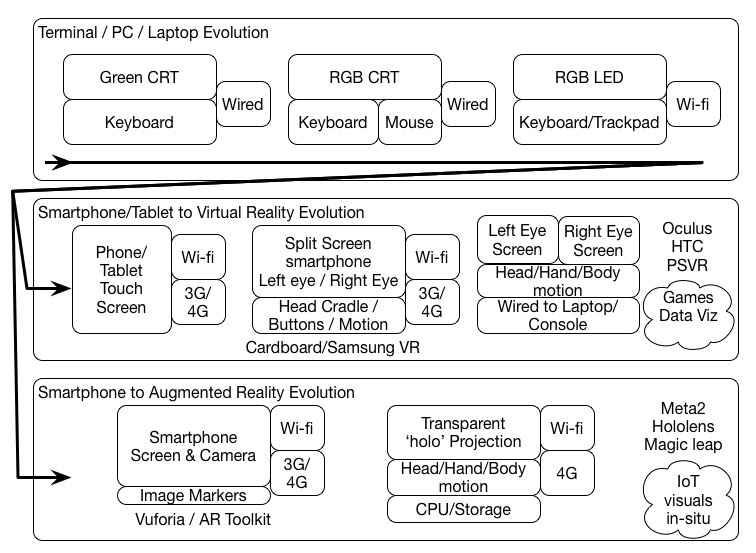
Interestingly lots of AR tech is being retro fitted to VR. Nothing is ever clear cut, but its good to spot a trend or find a theory to explore.
Of course my IoT VR and AR experiences blend into the books Reconfigure and even more so the follow up Cont3xt and the adventures are still selling and being downloaded at $0.99 around the World. A few more reviews would be great. In some of my briefings some of the elements I have used start to get a little closer to reality, but it was always supposed to be near real sci-fi.
I have not thrown away my tech hands on approach to things though. Yes there is a lot of writing but the predlets still need to get the opportunity to learn their craft and this morning my/their BBC Micro:bit arrived. A fascinating Arduino like controller but loaded with LED’s, compass, bluetooth and gyroscopes. It will be great to see what they get up to with it. It is a full IoT endpoint when it comes to it.
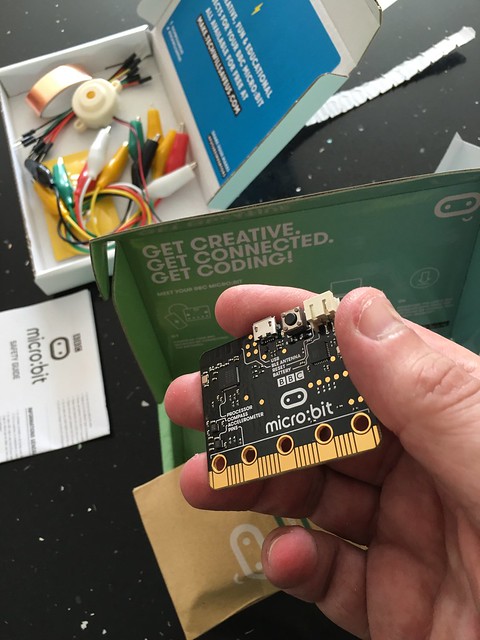
Its not all work, though a lot of my play is work related too. However, we invested in a Wheel for the Xbox One, having had one on the 360. It was part present for predlet 2.0 getting a great school report and a pen licence. This time I also got a proper stand for it the Wheel Stand Pro V2. It makes a huge difference to all the driving games, particularly the rock hard Dirt 2 and Forza 6. Of course there is a prime example of where VR works, and I believe the PC version of Dirt now has headset support. If they sort it out for the Xbox, well I am in 🙂
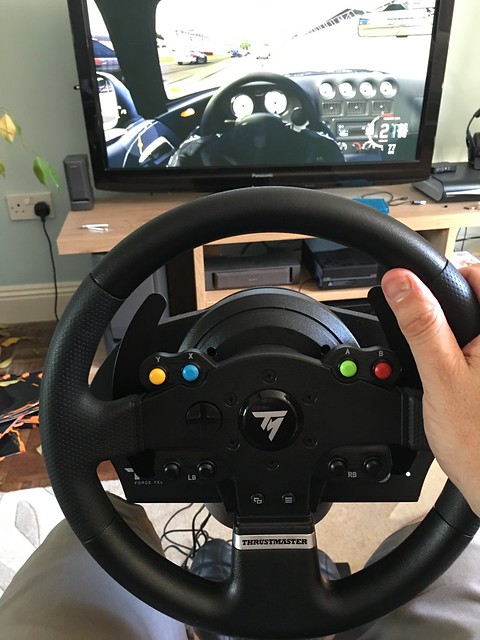
Another addition and a rather fantastic one was my Father’s day present of next generation slot(less) racing with Anki Overdrive. These fascinating cars read the track as they race on it, making any layout they will autonomously drive around mapping the reach first they you get to race using you phone/tablet. Switching lanes and controlling speed and virtual weapons and defences. They are fast and frenetic, and when they go off track they razz around trying to find it again. Watching the robot cars drive is pretty magical too. I know how they work, I know what they are doing, but…. wow. Once again another IoT style twist in the tail. Alluding to where the World is going, first liberating the ideas from play, just like Pokemon Go has.
If you want to see the diverse list of 451 Research reports I have been doing look here, thats not including all the press articles and conferences presenting I have been up to in just a few short months.
If you have anything industrial, enterprise or just plain quirky you would like to talk about please get in touch I am @epredator and do take a look at the books for some summer reading 🙂
BBC Micro:bit – It’s taken a while but worth it
I have always been keen that kids learn to code early on. Not to make them all software engineers but to help find those that can be, and also to help everyone get an appreciation of what goes into the devices, games and things we all totally depend on now.
Way back in the last ever Cool Stuff Collective (in 2011 !) I did a round up of all things tech coming in the future. I begged kids to hassle their teachers to learn to program
It was looking as if the Raspberry Pi was going to be the choice for a big push into schools. It is probably even why our show was seen as too common to be allowed to show the early version. I was keen to have the Pi on but that didn’t work out. We had already done the Arduino on a previous show and that seemed to work really well.
So I was very pleased to see the BBC Micro:bit arrive on the scene last week. The Raspberry Pi is a great small computer, it is however quite a techie thing to get going as you have to be managing operating systems, drivers etc. (Though things like the Kano make that much much easier)
Arduino are great for being able to plug things into though it requires some circuitry and connections on breadboard to start to make sense of it. The programming environment allows a lot oa things to be achieved. It is a micro controller not a full working computer.

The new BBC micro:bit is a step in from the Arduino. It has an array of LED lights on it as its own display but also has bluetooth and a collection of sensors already onboard.
I was very pleased to see the involvement of Technology WilL Save Us in the design. I met and shared the stage with the co founder of this maker group Daniel Hirschman @danielhirschman at the GOTO conference in Amsterdam a couple of years ago. He knows his stuff and is passionate about how to get kids involved in tech so I know that this is a great step and a good piece of kit.
The plans to roll this out to every year 7 student is great, though predlet 1.0 is just moving up out of that year. So I will just have to buy one when we can.
Microsoft have a great video to describe it too.
I am sure STEMnet ambassadors in the filed of computing will be interested and hopefully excited too. This is important, as it is not just code it is physical computing, understanding sensors what can and can’t be done. It is an internet of things (IOT) device and it is powered by a web based programming language. It is definitely off the moment and the right time for it. Oh and its not just an “app” 🙂
Kids,video games, parents and ratings
There has been a lot of press and discussion about schools in the UK writing to parents to warn them about young children playing video games. Also indicating that allowing kids to play games rated 18 when they are underage is a sign of neglect and will lead to the parents being reported to police. The BBC covered it here
As a parent, as a school governor, an instructor and long term gamer it seems that this raises a few much more complex issues.
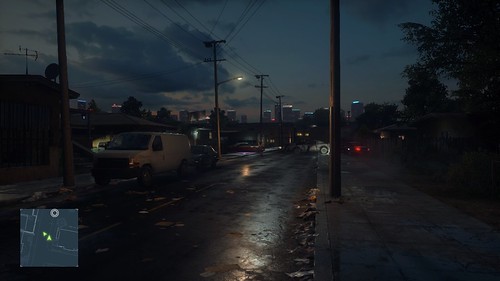
An 18 certificate on anything helps flag up content of a nature regarded as adult. However it does not indicate which of the adult themes it contains. You may notice on films on TV it will say its 18 but whether it contains violence, drug use, nudity, etc. That informs the viewer if they are sensitive or prefer not to watch such things to avoid it.
A parent should know what is in a product that they let their kids loose on. The 18 should be a big flag warning that there may be something in there that is not appropriate. However not all parts of all games are really 18 worthy. It is a marketing ploy to get more adult gamers to slip a few things in sometimes to warrant an 18. It also is down to individual parents bothering about how notice if their kids are affected or going to be affected by certain things.
Make no mistake though, there are some things in games that are really properly challenging and grown up experiences. Sometimes they can sneak up on you and often come as part of a wider narrative. As an example in Red Dead Redemption, an 18, the vast majority of the game is spent riding around the Wild West on a horse. Yes there are gun fights and shooting. However it is no more or less than watching a John Wayne movie.
“John Wayne – 1961” by 20th Century Fox – eBay. Licensed under Public Domain via Wikimedia Commons.
Cowboy movies sometimes have to deal with complex issues but they come in many flavours. There is always lots of shooting and death but it is the core and the intent of the film, either being light and comical or the more gritty true to life versions that form the spectrum. RDR seemed in the most part to be the former. I grew up watching westerns and we all had six shooters for toys.However about 2/3 through as the character arrives in Mexico a story telling cut scene featured graphic rape scene. Usually you get a sense and feel for the spirit of a game as you play it. You spot that it might be a cert 18 because of the “violence”, this though seemed a shift.
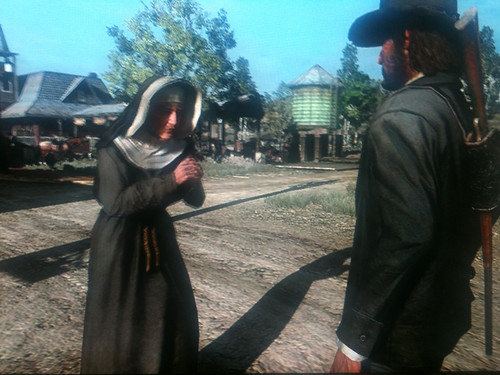
Now lets take Call of Duty (Bear in mind you can get Call of Duty Lego). The single player campaign game in all these games is a full on war film equivalent. However it is more Saving Private Ryan than Where Eagles Dare.
Both great films, but the former is realistic and disturbing, the latter is a playful romp. So single player you will experience some degree of story, probably torture, murder et al. Also some very strong language. It changes a great deal in multiplayer. Here teams of people online shoot at one another and work as teams to capture objectives. The violence is more Where Eagles Dare. It is frenetic and fast paced. The risk here comes from the other people, with headsets and voice turned on then all sorts of bullying and offensive language can take place, equally friendly banter and trash talk. Or, when done right excellent teamwork. The soundtrack itself features very little produced content. The narrative is what you make it.
In many ways the multiplayer COD is less worrying than what can happen on a Minecraft server. Minecraft as a game feature the ability for people to treat one another nicely or nastily. Whilst there is not usually voice you can spend ages building something for someone to come and mess it up accidentally or maliciously. It can also be a great place to learn online etiquette. Minecraft is not an 18. You kill things, but its regarded as cartoon and left alone. It has no story to warrant someone put in some nasty scenes to provide an emotion.
My point is that 18 is a flag, a warning sign. It takes a bit of effort to drill down if you are going to let kids experience the good parts of these.
I am happy for kids to shoot at one another in these games, it is just a twitch reaction game. I am not happy for them to play the single player experiences, those things crafted to shock and engage adults on adult themes. So I wonder if that makes me negligent? Being happy that kids can see some content that is put under an 18 certificate?
This of course is not what is going to happen. These warnings are to remind parents to be parents, to think about what they are doing, to help guide their kids.
Both the predlets are martial artists. They train in punching and kicking in ways that if used properly are very dangerous. They see punches and kicks all the time yet it is all done in a positive way, one that is not about the aggression of the will to dominate others. They are taught to not misuse what they learn in class. Does that mean that playing a fighting game with an rating over their age is not appropriate, often these at 16 like the UFC game or even WWE?
So all this comes down to context. To understanding when game does not mean light hearted play but intense narrative. It means understanding when competition is or isn’t healthy. It requires us as parents to understand a what is going on in these experiences and how we can find the appropriate path for our kids.
The age rating on these things is a relic of a past approach to media. It is very easy to classify 2 hours of celluloid, The 18 certificate is then a barrier to entry to a cinema when a person is selling a ticket, or even buying a DVD.
Games and their associated places are far more complex. They are playing fields where at different times with different groups very different things happen.
I am not totally sure how we can help all the parents out there. Many of course will just not bother to apply any thought at all and just let their kids on anything, on the basis it is easier.
Martial Arts, Science and Tech for Secondary School
Having returned for a great snowboarding and skiing holiday with the family,
I dived straight back into presenting and explaining science and tech. This was a slightly different request through STEMnet though. A local secondary school teacher asked if I could come and take about biomechanics and martial arts to try and help her students see why science is still an important subject to stick with.
I ran two sessions but built a new presentation specifically for this audience and reason.
Usually I am explaining tech, the future, metaverses etc but putting things like Choi Kwang Do and learning guitar into the mix to make things a little more human.
This time though the hook was martial arts. As Martial arts are not generally taught in school (though the should ideally be part of the curriculum) they are something that has a degree of intrigue to people. Choi Kwang Do in particular is based around a lot of ground up application of scientific principles. It is also not a combat sport, but a defence art aimed at improving your overall mental and physical well being. i.e. it’s idea; for this sort of talk.
I am not going to post the presentation as it featured a lot of video, very few words on slides and a lot of talking and demonstration.
The format though was….
1. Intro to who I am, what I do. I was wearing my Dobok and belt as part of the impact, but indicating my background and work as a techie. I also showed some custard pie throwing from The Cool Stuff Collective. My aim was to show that breadth of knowledge and experience is important and the ability to change is key.
2. I gave a potted history of CKD and showed some of the variety of people performing CKD. I showed predlet 1.0 in a video at a showcase event. It had all ages, sizes and abilities of people in it. The aim to remove the macho, teenage boys only, type of image and engage the entire class. I explained the classes that Master Scrimshaw runs in basingstoke too. I also had the values and pledge on screen to mention.
3. Next up was to talk about Psychology. In part this was about mental states. Dealing with the transition from relaxed, to wary to fight or flight. How the fight or flight state causes massive physical and chemical changes. How being aware of those changes, finding ways to avoid or positively use those is a fundamental part of any martial art. How being in the red and stressed when you don’t need to be will make you ill etc.
4. Physics was next. I pointed out that in a martial art Force = Mass x Acceleration is key. Learning ways to project as much of your mass as possible, as fast as possible is what the techniques are designed to do. Understanding forces and what they are apply to any sport, golf, football, tennis. However I also broke out into showing how we need to understand forces like gravity and cohesion in game development and animations. Here I was aiming to jump subjects to show that the same science and understanding is needing in something very physical and in something, like games development, that is more sat at a desk. The same science.
Also here I played a little trick. Whilst talking about the forces I suddenly jumped into stance and gave a very loud guttural kihap (Martial art shout). This made pretty much everyone jump. A fairly drastic pace change but the aim was to then remind everyone of the conversation about fight of flight earlier on. I pointed out that for me as the shouter, I had gained control, I had positive vibes and chemicals flowing and I was ready. For the class they were for a fraction of a second confused. Their body will have gone straight to code red, in fact jumping was part of fight or flight but almost taking them into tonic immobility, frozen in fear. A simple loud noise, out of context had caused metabolic changes in all of them. i.e. make the science personal and relevant.
Those that already did martial arts, there were a few in each class, were less bothered, seemed more relaxed as they were subconsciously dealing with the threat assessment.
5. I continued to talk about physics and relate that to biomechanics and anatomy. Understanding how to flow movements across your body to generate the acceleration.
6. This led to the neuroscience part. I shared how we learn patterns and sequential movement fits with the way the brain likes to absorb information. Moving from short to long term memory and able to operate when in flow mode works better if the thing you are learning has a completeness to it and a known pattern. In CKD we start and finish in the same place in most moves, we also follow a rounded non stressful sequence. Again I related this to video games and how we learn patterns to deal with situations in games. Discovering the pattern is the joy of play, followed by the mastery of that pattern, getting faster and better scores. Good games need to layer new patterns on old to avoid boredom. Likewise in CKD training we layer onto of mastered moves and patterns with new ones. At its root it all goes back to basics.
I also discussed contralateral movement, working the whole body on both sides for both parts of the brain to create cross hemisphere pathways as the brains neuroplasticity is exercised.
I used the example from Heston Blumenthal of the cinnamon and vanilla ice cream too. Again this was to break the subject, change the mental senses used by the group. With the ice cream made from both vanilla and cinnamon if you sniff cinnamon before tasting the ice cream you will only taste vanilla, like wise with vanilla sniffed first you will only taste cinnamon. This illustrates how you brain and neurochemistry is rigged to look for large changes. You brain filters things out to avoid overloading. The familiar is relegated in favour of the new.
I also discussed how the brain goes into an intense learning mode after a burst of exercise. This seems to be related to reflecting on what a situation was that caused you you be stressed and to escape, how you did it and how you won’t get eaten/killed/caught next time. So we can use our naturally evolved mechanism to increase out learning ability by piggy backing on that fight or flight calm down state.
7.Last up was metabolism. A basic example of the Krebbs cycle, the production and use of ATP as a mini fast access energy source in cells. I did not major on this but used it as a framework to discuss the 15 second bursts of exercise versus the 30 minute aerobic ones. In a defence situation you need to be explosive and able to release the ATP energy, quickly and efficiently and then get away. (Or not be there in the first place which is much better!)
Before heading into the last section I also shared the amazing journey of Sabunim Robbie Close. He went from a very quiet and shy teenage to an assistant instructor then a blackbelt and was then picked to go to Hanseo University in Korea to study a Degree in Choi Kwang Do. This martial art had transformed his outlook, and his life. We had the pleasure of him popping along to Basingstoke for a visit. As the class I was talking to was the age he was when he started it was great to have such a positive role model to share.
8.My final section moved more into the normal territory of discussion using the kinect to see how the body works. I related this again to biomechanics and then also to how we animate game characters and rig bones and joints. I ended up showing Microsoft HoloLens as a mandatory virtual world/metaverse, look here is the future and you can be part of it… the of conversation.
It was a very productive session I think on both occasions, and I hope to run some more. It covers all sorts of science and tech and it may help a few people see the relevance of science in life, or even better see the relevance of a martial art such as Choi Kwang Do.
Primary school computing – Barefoot
The past few years have seen a real recognition that computational thinking needs to be part of everyones education from a very young age. The UK national curriculum had some massive changes to introduce this, which is great, but it was not always matched with any resources or training to help anyone who was not a techie and programmer from understanding it let alone then be able to teach it.
I like to make people feel comfortable with technology and explain how it fits into what they know, how it can improve, or threaten their experience. So was very happy to see this initiative. Barefoot Computing is an initiative from the BCS The Chartered Institute for IT and supported by Computing at School. It seems to be a complete system of curated content that is not solely about programming or tech.
Instead it looks at how to transition what teachers know and teach already and frame that into the basis of the next steps in teaching computing. It also them provides free resources to help teach, lesson plans, Scratch programming assets etc.
It is also not simplistic, it is not a “just code”. One of the most important and striking use of word as an entire category is “tinkering”. The fact that lesson plans and the resources include specifics about letting go, allowing exploration by the students to see what happens struck me as very different.
Each of the plans is tagged with specific helpful icons that indicate the point of the lesson. These in their own right are very useful and telling about how this is all structured.
I have image captured from the site, just as an example to be able to talk through, but go and take a look, there is a free registration. It is worth us all knowing the resource is there, to share with schools and colleagues. Or better still get one of us the STEMnet and Barefoot computing volunteers to come into school and share it with the teaching staff.

Here we have the core approaches to computational thinking.
Tinkering, finding out what happens and discovering new things is the first on the list!
Debugging sounds a bit more techie, but it is spotting whats wrong it anything and fixing it.
Persevering. This is not something you usually see in “tech” presentations. Something not working, not operating as you expected is a normal part of the business. It is an important aspect of life.
Collaborating. Working with others is also essential.
You can se these are not computing specific. They apply to every walk of life and and experience. In my martial art Choi Kwang Do, Perseverance is a key principle. We tinker and debug as we learn about how to perform our moves, adjust, apply a what if approach and finally we work together in a friendly environment. This just happens to be focussed on programming, but it is so much more!
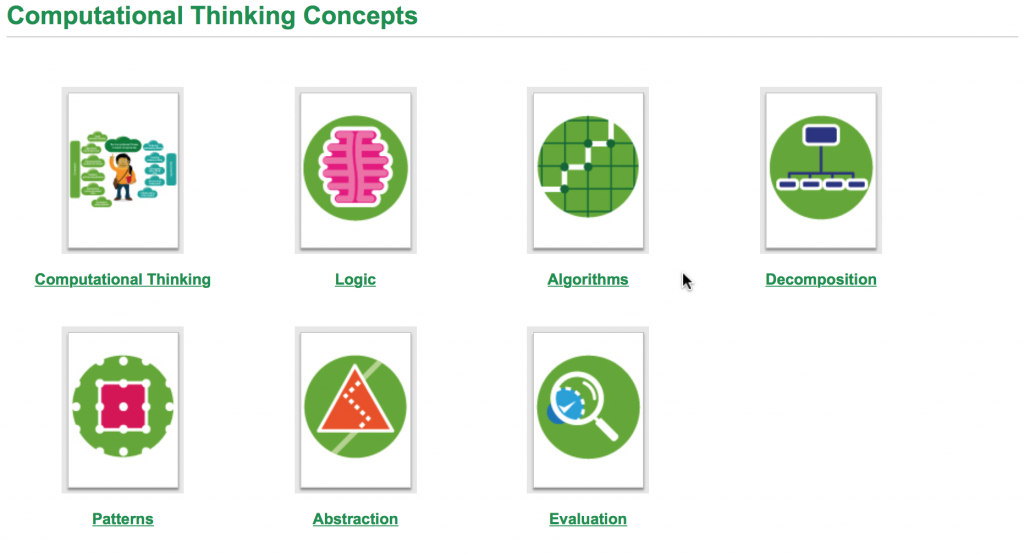
Clearly this next layer looks more like the technology words we use in the industry, but again many of them are applicable in non keyboard related instances. Breaking problems down, spotting patterns, making things repeatable are all key elements.
All these are setting the scene before the specifics that make up computer science. The nuts and bolts of what we do as programmers and architects. Now if you came at computing with this list below it would be a lot more overwhelming, even though each element is relatively simple as a concept.
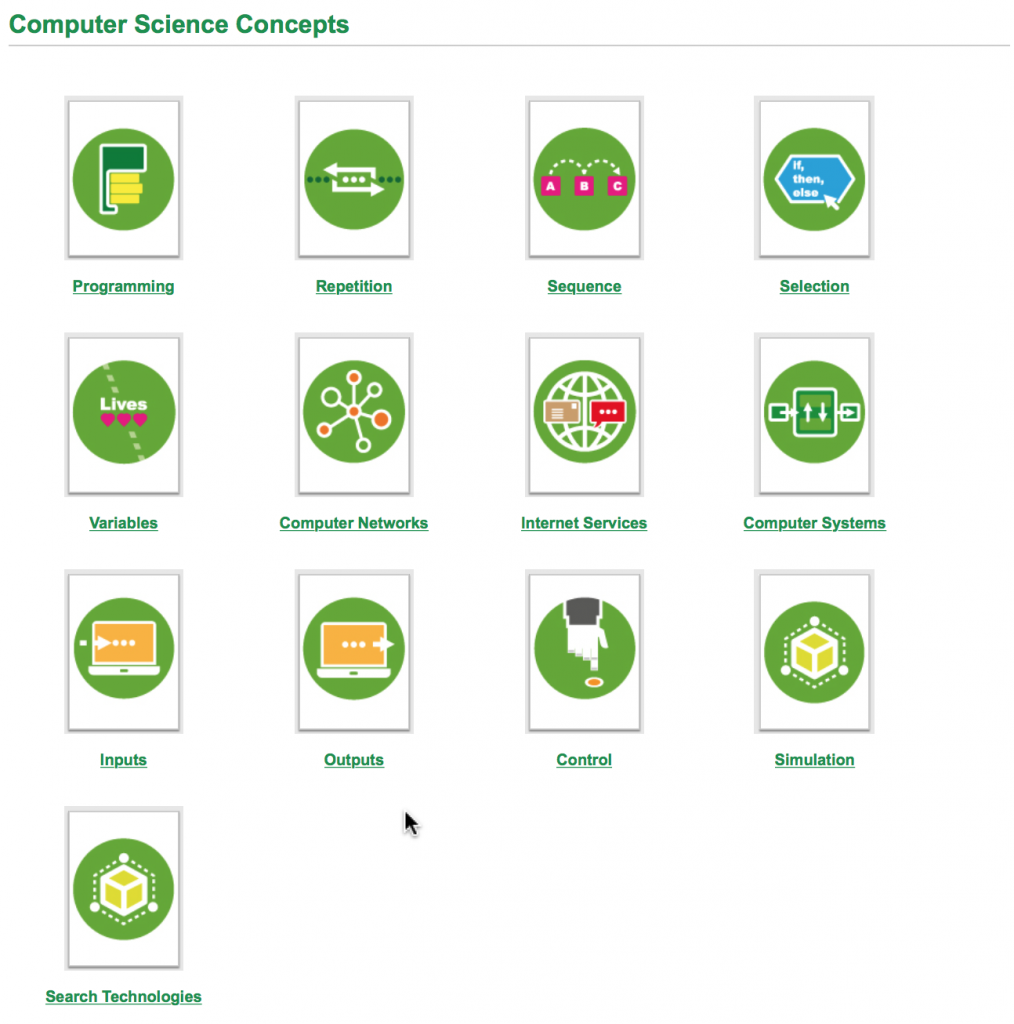
Very often as techies this is what we hit people with. Often in order to help them understand the beauty and elegance in the art of programming, or as a weapon to maintain a technical dominance.
In all these icons though my favourite is the variables one. It specifically shows the word lives and 3 hearts. The number of lives you have in a game is a variable. It goes down (sometimes up if you hit a bonus). For me the variable was the part of the aha moment, when all computing became clear for me.
I started computing at school to work out how Space Invaders worked. We were writing a program in class dealing with electricity bills. It had a loop to recalculate a bill based on different inputs. It was a variable we were setting. It all seemed like a weird mess of symbols until it clicked that the thing we were setting and how it stayed set or got changed by the code was the same as the score in space invaders! It was also the same as the position of each invader, where the player was etc… Kaboom! a life changing understanding of something that seems laughably simple when you spot it and then apply the pattern repeatedly to other situations.
So, a big thumbs up from me and I will be helping predlets school, and any others that need it with this set of resources as a starting point.
Kano – Coding for Kids (of all ages!)
Recently my Kano arrived that I had backed a while ago on Kickstarter. Kano is a computer that you make yourself. When I backed this originally it looked like a good way to package up a Raspberry Pi computer to make it more human friendly. (The Pi is great but the original vanilla version were a lot of linux messing around to get working, that was of course early days).
Kano has packaged up a Raspberry Pi and provided a lovely collection of kit that allows you (or your kids) to get this small computer up and running.
The kit comes in a cardboard box, but it is a box with a flipped magnetic lid so it is more of a case really. The most striking piece is the orange wireless keyboard with built in track pad. This on its own is a great piece of kit. Small and very handy. It has a USB cable folded into the back of it, but this is just for charging it. It’s very nice indeed. My previous PI’s I used a full size wireless keyboard I had. It always seems wrong when the input device is soo much bigger than the device itself.
The instructions are written in two books one for assembly and one for getting coding. For this I tried to let predlet 2.0 just follow those himself to see how they worked.
I did help with a bit of clipping the case in but that was really just me itching to see all the elements.
After the build you are left with a Pi in a clear case (with some customisation panels) an attached speaker and several cables. HDMI for the TV and a a power lead. It comes with a ready prepared operating system on an SD card and with a wifi wireless dongle too.
We plugged into one of the gaming TV’s and away predlet 2.0 went. There was of course the obligatory patch, this took a little while but there were a set of screens to read about computing and how it all works.
As you can see, whilst you have the BIOS style boot screen initially after that it is all very slick looking and more like a computer they will have been used too. It is not all command line hacking.
The user creates a name and then an online account with Kano. This gives access to all sorts of things and a sort of scratch like repository of shared programming experiments. It is also very much like an xbox or playstation account. There is an avatar, customisable of course. There are also lots of points and badges for achievements using the system. This seems to work well to get past those initial possibly confusing stages.
Predlet 2.0 say the minecraft logo and wanted to dive straight into that. For once though I insisted he worked through the book as I wanted to see how it gelled with him.
The first task is a little unusual in that it asks the user to get an ASCII version of snake up and running via the command line. It then explains this basic game has lots of sets of parameters and being able to type –help etc on the CLI. This is a skill that is needed but this almost would lose a lot of kids right away. The achievements system does a lot to mitigate that. I grew up on CLI’s I still have to use them. Hitting them with this first of all to get the potentially boring bit out of the way makes sense too. I still was little disappointed by that bit but Predlet 2.0 battled on.
The remaining tasks involve diving into the visual programming Kano blocks. The example uses a version of pong and then gets the user to use the programming blocks to drag onto the workspace and change how things operate. The lessons are good and cover a range of techniques. This was certainly more fun. Kano blocks looks and acts like Scratch which is handy as Predlet 2.0 had some experience tinkering with that. It does also point out that you can see the Python code that blocks generates, this is a good thing as whilst CLI’s may not be great IMHO getting to real code is essential at some point. Visual composition has come a long way but having both views of the code is much more useful.
After pong we dived into the minecraft version. The Pi being a smaller machine means its not going to have the draw distance and world size of a PC or Xbox but it is instantly familiar to most kids.
The screen is split horizontally, almost like a two player game would be.
The top half is Minecraft, moving around building with individual blocks. The bottom of the screen is a Kano Block version of a console. Here the lessons show how code can be run to alter the world. Normally in Minecraft you build a block at a time. Predlet 2.0 was instantly amazed when he did a draw command and loop in Kano blocks that created a 20x20x20 block. One of the other examples creates a long think wall of stone and then a thinner wall of air inside generating an instant tunnel. That was powerful. Because of the scratch he had done and the hours of Minecraft on every platform predlet 2.0 had a bit of a eureka moment I think. This was the real level of understanding of the power of programming. I only got that at 14 when it suddenly dawned on me, but home machines were somewhat rarer.
Now we have a £99 kids friendly machine, something that was the aim of Raspberry PI but they could only go so far sorting out the hardware. Kano is a package and an experience. It does protect from some of the hacking needed, but that is its point. Get them in, let them play then they will learn to hack and code.
We spent about 3 hours straight on this, and I am looking forward to the next session we have. There are some instructions on using VNC and remote access into the device so that an ipad screen can be used.
This kit should be in every primary (and secondary school) right now!
Minecraft mirror worlds
Way back in 2006 when many of us started to use the persistent multi user networked virtual world with self created content (Second Life) in all sort so of place like business and education we thought we were on the cusp of a virtual world revolution. As a metaverse evangelist in a large corporation it was often an uphill struggle to persuade people that communicating in what looked like a game environment was valuable and worthwhile. It is of course valuable and worthwhile but not everyone see that straight away. In fact some people went out of their way to stop virtual environments and the people that supported and pioneered their use. Being a tech evangelist means patiently putting up with the same non arguments and helping people get to the right decision. Some people of course just can’t get past their pride, but you can’t win them all.
For me and my fellow renegades it started small in Second Life
I also captured many of the events over the course that first year in a larger set along with loads of blog posts on eightbar including this my first public post that always brings back a lot of memories of the time and place. It was a risky thing to post (if you are worried about career prospects and job security) to publicly post about something that you know is interesting and important but that is not totally supported.
One of the many ways people came to terms with virtual worlds was in the creation of mirror worlds. We all do it. In a world of infinite digital possibilities we ground ourselves by remaking out home, our office our locale. We have meeting rooms with seats and screens for powerpoint. This is not wrong. As I wrote in 2008 when we had a massive virtual worlds conference in London
It seems we are seeing many more mirror world applications appear once more and generally the builds are in Minecraft. It is interesting Minecraft has all the attributes of more detailed virtual worlds like Second Life and Opensim. It is a persistent virtual environment. It has the 8 bit block look and much less detailed and animated avatars, but it does have a very easy approach to building. You stack blocks. You still have to navigate the 3d space get you first person view in the right place and drop a block. (Many of the objects in 2006 were from people who felt they could not navigate 3d space easily something I think that has started to melt away as an objection). The relative resolution of a build in minecraft is low, you are not building with pixels but with large textured blocks. This does have a great levelling effect though. The richer environments require some other 3d and texturing skills to make things that look good. Minecraft is often compared to Lego. In Lego you can make very clever constructions but they still look like Lego. This becomes much less of an visual design challenge for those people less skilled in that art. A reduced pallet and single block type means not having to understand how to twist graphic primitives, upload textures and consider lighting maps etc. It is a very direct and instant medium. Minecraft has blocks that act as switches and wires that allows the creation of devices that react, but it does not have the feature that I used the most in Second Life and Opensim of being able to write code in the objects. There are ways to write code for Minecraft mods but it is not as instant as the sort of code scripts in objects in more advance virtual environments.Those scripts alter the world, respond to it push data to the outside and pull it back to the inside. It allows for a more blended interaction with the rest of the physical and digital world. Preserving state, creating user interfaces etc. It is all stuff that can be done with toolsets like Unity3d and Unreal Engine etc, but those are full dev environments. Scripting is an important element unless you are just creating a static exhibit for people to interact in. Minecraft also lack many of the human to human communication channels. It does not have voice chat by default though it is side loaded in some platforms. It has text chat but it is very console based and not accessible to many people. The social virtual worlds thrive on not just positional communication (as in Minecraft you can stand near something or someone) but on other verbal and non verbal communication.
The popularity of Minecraft has led to some institutions using it to create or wish to create mirror worlds. Already there was the the Ordanance Survey UK creation which “is believed to be the biggest Minecraft map made using real-world geographic data.” (Claiming firsts for things was a big thing back in 2006/7 for virtual worlds). It has just been updated to include houses not just terrain. By houses though this is not a full recreation of your house to walk into but a block showing its position and boundary. This map uses 83 billion blocks each at showing 25m of the UK, according to a story by the BBC
The BBC also reported this week on the British Museum looking at recreating all its exhibits and its buildings in Minecraft. This is an unusual approach to their exhibits. It will be an interesting build and they are asking the public to help. So once again Minecraft’s simplicity and accessibility will allow anyone to create the artefacts. It will, however, create a very low rez low texture experience. So it is a mirror world, in that it will be like the museum but it is more of a model village approach. You admire the talent to make it in the medium. It seems more of an art project than a virtual world project. It is all good though 🙂
The BBC seem to be on a Minecraft vibe just as they were on a Second Life Vibe back in the last wave. Paul Mason and BBC Newsnight came and did a piece with me and the team of fellow Virtual World pioneers in 2007 We were starting to establish a major sub culture in the corporate world of innovators and explorers looking into who we could use virtual worlds and how it felt. Counter culture of this nature in a corporate is not always popular. I have written this before but the day we filmed this for the BBC in the morning I had my yearly appraisal. My management line we not keen on virtual worlds not the success so gave me the lowest rating they could. I went straight for that (which is very annoying and disheartening) into an interview with Paul on camera. Sometimes you just have to put up with misguided people trying to derail you, other times you just get out of the situation and go do it elsewhere.
Anyway, Minecraft offers a great deal, it does allow mirror worlds, though it does allow for an other worldy approach. Most blocks do not obey gravity. You can build up and then a platform out with no supporting structure, you can dig tunnels and underground (the point of the mine in Minecraft and not worry about collapsing. You still have real world up and down left and right though. Most virtual worlds do this. Disney Infinity, Project Spark, Second Life, Opensim and the new Hi-Fidelity etc are all still avatars and islands at their core. People might mess with the scale of things and the size, size as the OS map or the Hard Drive machines and Guitars mentioned in this BBC piece on spectacular builds.
I feel we have another step to take in how we interact at distance or over time with others. Persistent virtual worlds allow us to either be in them, or even better to actually be them. My analogy here is that I could invite you to my mind and my thoughts, represented in a virtual environment. It may not be that those things are actual mirrors of the real world, they might be concepts and ideas represented in all sorts of ways. It may not mean gravity and ground need to exists. We are not going to get to this until we have all been through mirror work and virtual world experiences. That is the foundation of understanding.
Whilst many people got the virtual worlds of Second Life et al back in 2006 we were only continuing the ground preparation of all the other virtual world pioneers before. Minecraft is the first experience to really lay the foundations (all very serious it is fun to play with too!). These simple 8 bit style virtual bricks are the training ground for the next wave of virtual worlds, user generated content and our experiences of one another ideas. They may be mirror worlds, they have great value. There is no point me building an esoteric hospital experience when we need to have real examples to train on. However there is a point to having a stylised galleon floating in space as a theme for our group counselling experience we created.
The test for the naysayers of “it looks like a game” is really dying off now it seems. It will instead be it does’t look like the right sort of game. This is progress and I still get a rush when I see people understand the potential we have to connect and communicate in business, art, education or just good old entertainment. We could all sit and scoff as say yeah we’ve done that already, yes we know that etc. I am less worried about that, there might be a little voice in me saying I told you so, or wow how wrong were you to try and put a stop to this you muppets, but it is a very quiet voice. I want every one to feel the rush of potential that I felt when it clicked for me, whatever their attitude was before. So bring it on 🙂
Fantastic use of 3d printing – we need more of this!
Thankyou to @marleyman007 for pinging me this link on twitter it. It made me feel really happy to two reasons.
The first is very obvious. 3D printing making a positive impact, but in a fun and unusual way on peoples lives.

(Photo By Aaron Brown creator of the print)
Based on idea from an organisation called e-NABLE where a network of people interested in 3d printing and in making a difference are designing and 3d printing prosthetic hands for kids, he created this super hero hand based on Wolverine. Now that has to make you get a little buzz of excitement and joy and will surely help people see the 3d printing revolution and suddenly realise its potential.
The other reason this made me smile and somewhat energised is the loop that has now come full circle. As you know I like to share ideas. A few years back in 2010 my friend Scotty aka @starbase37 set up a meeting with John Marley (@marleyman007) and I to talk about tech. John was starting with a pitch for the TV show The Cool Stuff Collective. Scotty had pinter him to my blog as a way of finding out new stuff. That meeting led to John asking me to not just help research but to present on The Cool Stuff Collective as Super g33k 🙂 The one the first two shows we recorded featured 3d printing.
It was September 4th 2010 that I wrote about that. (Is it really 4 years ago!). Now this blog post features something that John has sent to me over Twitter :).
We revisited 3d printing in series 3 too with the reprap. I am very proud we were able to show 7-12 year olds 3d printing on the TV 4 years ago. Image that! some of them are now approaching A-Levels.
The last thing I said on the last show in a round up was that I really hoped that we would get technology properly taught in schools, to allow kids to be able to make and create with tech not just use. That is certainly heading the right direction despite all the arguments about whether coding is coding for codings sake etc. The BBC have new assets and a plan to involved computing more in various programmes including Nina and the Nuerons which is a great place for it to be represented on Cbeebies.
Meanwhile in the past 4 years there has been a massive change in how kids engage with tv and media content. Many of them are self broadcasting things such as gameplay on Twitch.tv or spending a lot of time watching minecraft videos from Stampylonghead
He and his fellow casters have created a style of commentary on games that is about fun and exploration. It has certainly led to the predlets spending a lot of time talking and explaining what they are doing whilst they play, usually with a silly voice and lots of screams and whoops.
I do get asked why there are no more Cool Stuff Collective shows. It is something that would be great to do again. There is more new tech than ever that is accessible to young and old alike. There is room to find things that can be shared, but that can also be used in school and at home. Whether the regular TV format for kids tv is suffering a demise, or if it is just morphing into a more shared online experience is hard to tell. I have an image in my head of a show that truly crosses the borders. I recently added this comment to a thread on Facebook about the coding or not argument and the relevance of TV
” Imagine the show being a catchup on a massive open source application gathering. Live hackathons with audience participation. Bringing everyone into the “project” designers, writers, coders , testers, art and science mixed. Live touch points across the web, assets to share and update. Voting features and project aims up and down.
Take all that stuff tv does for no reason like xfactor votes and direct it to mass creation. It does not just have to focus on code. It could be awesome.”
There is certainly content to be shared, in a different way to the excellent Gadget Show or other Gadget/science programmes. A merging of live and online interaction, even thread of storyline created through synchronous and asynchronous audience participation.
So whilst I get teary eyed (in a good way) looking back at Cool Stuff Collective, where I had some of the best times ever and most fun “working”, I am still very proud of what we covered but I know we (or someone) could cover the new things in a new way. The thing with kids TV is that you have an impact on a cohort and then they move on. If we can reach this current batch of 7-11 year olds and support and inspire them to understand and build with technology then we have a great future ahead of us. For now I will try and catch things here and also longer explanations of the world of tech and evolutions in Flush Magazine and occasionally look at the old footage in the showreel and smile 🙂
BCS Bristol – Guitars and games, changing peoples lives with martial arts
Yesterday I braved the
Thankyou to everyone at BCS Bristol. Thankyou also for the very kind comments and great conversations afterwards. It means a great deal to me that I help people see things in a new light through sharing these personal experiences powered by game technology.
I should add that the 90 miles home was a good straight run in the car, hardly any “weather” to speak of. Quite a relief.
